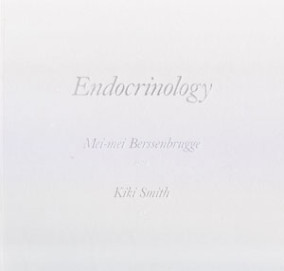 Mei-mei Berssenbrugge
Mei-mei Berssenbrugge
Kelsey St. Press ($17)
by Charles Alexander
Endocrinology's plain cover (one-color type and no illustration on gray recycled paper) portends, as does the title, a major change in Mei-mei Berssenbrugge's work. The author once stated that she made two commitments when young—to beauty, and to the sentence. These aspects of her work came to a stunning peak in Sphericity and Empathy, where her long lines and sentences paralleled the New Mexico horizon of her home and the breathlessness of those lines performed a hushed beauty before our eyes and within our ears.
Here, sentences become phrases, and beauty, if it exists, embraces a stunted music of cut lines and a content that includes intestines, blood, viruses, and cell growing in a petri dish. The movement from outside to inside the body takes place on the very first page:
The bird watches the man and woman dance.
He touches her stomach.
There's circulation around her in intercapillary space,
empty or hollow, in relation to organs.
What is inside / what is outside? Here "around her" may be within her, or perhaps the suggestion is that all outside space is "intercapillary," between the bodies' organs, and relates to them—what an extraordinary definition of space as social!
 It is impossible to talk about this book without talking about its physicality. The poem's lines on strips of white color float on the more neutral-colored but active paper; surrounding them are dark illustrations, which are like rough sketches of organs and parts of plants, and single hand-written words. Visual artist Kiki Smith, Berssenbrugge's collaborator, is an equal contributor to the experience of reading the work. The visual presence of cut lines and phrases parallels the way Berssenbrugge writes; by compiling sources and observations until there is a mass, she gradually, often over months or years, pares away and shapes a final work. The way the physical nature of the book intrudes and effects Endocrinology means that the work cannot be read as a nonphysical text. The reader/viewer absorbs the whole of the work as a tactile compilation of fragmentary observations, conceptions, and questions. All provoke and all point, either directly or in their odd juxtaposition, to a transgression of the body's bounds.
It is impossible to talk about this book without talking about its physicality. The poem's lines on strips of white color float on the more neutral-colored but active paper; surrounding them are dark illustrations, which are like rough sketches of organs and parts of plants, and single hand-written words. Visual artist Kiki Smith, Berssenbrugge's collaborator, is an equal contributor to the experience of reading the work. The visual presence of cut lines and phrases parallels the way Berssenbrugge writes; by compiling sources and observations until there is a mass, she gradually, often over months or years, pares away and shapes a final work. The way the physical nature of the book intrudes and effects Endocrinology means that the work cannot be read as a nonphysical text. The reader/viewer absorbs the whole of the work as a tactile compilation of fragmentary observations, conceptions, and questions. All provoke and all point, either directly or in their odd juxtaposition, to a transgression of the body's bounds.
How much evolution derives from "something in the air,"
not a square of light above a niche in a white wall.
Light, your intestines. Fluid, lines of light.
In Endocrinology, horizon has moved inside: "The line between chemical and emotion is the horizon inside a niche in her body, transferring non-being to utility." Yet this must link, for the poet, to outside, "Where your eye goes over space to the horizon makes a whole, but where sky meets the earth, the fragment is not the same as a whole." The reader is located somewhere between these conceptions.
The false truism that a writer should write what she knows has harmed poetry and its readers. In Endocrinology, Berssenbrugge writes to find out. Along the way she joins light and body, cells and self, health and fate. Endocrinology claims the most private, interior of space as a place of social and linguistic exploration. In doing so, a new and strange beauty leaves us gaping.
The place where a word originates in her body is the
physical source of her sense of beauty,
so you can change the word for "happiness" that was
formerly, "innocence."
Berssenbrugge's forthcoming book, The Four Year Old Girl, promises to take us deeper into relationships of medicine and poetry, body and spirit. Both books arise from a deep involvement with her own immune system during the nearly nine years in which she has suffered immune dysfunctions following exposure to pesticide. Berssenbrugge wrote "The Four Year Old Girl" while imagining how not to pass the illness along to her four-year-old daughter, as well as imagining how meaning might encompass the betweenness one feels as one among many and as one consciousness both limited and not limited memory outlives the cell." Berssenbrugge's works provide places to live humbly and well in the body of language.
Rain Taxi Print Edition, Vol.3 No. 1, Spring (#9) | © Rain Taxi, Inc. 1998
